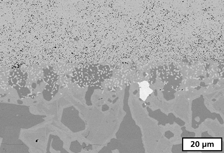Crossref Citations
This article has been cited by the following publications. This list is generated based on data provided by
Crossref.
Bergner, Anne
Moritz, Tassilo
and
Michaelis, Alexander
2015.
Interface Phenomena of Co-Sintered Steel-Zirconia Laminates.
Materials Science Forum,
Vol. 825-826,
Issue. ,
p.
289.
Scheithauer, U.
Schwarzer, E.
Haertel, A.
Richter, H.J.
Moritz, T.
and
Michaelis, A.
2016.
Additive Manufacturing and Strategic Technologies in Advanced Ceramics.
Vol. CCLVIII,
Issue. ,
p.
19.
Kalsoom, Umme
Nesterenko, Pavel N.
and
Paull, Brett
2016.
Recent developments in 3D printable composite materials.
RSC Advances,
Vol. 6,
Issue. 65,
p.
60355.
Scheithauer, U.
Schwarzer, E.
Ganzer, G.
Kornig, A.
Becker, W.
Reichelt, E.
Jahn, M.
Har‐tel, A.
Richter, H.J.
Moritz, T.
and
Michaelis, A.
2016.
Additive Manufacturing and Strategic Technologies in Advanced Ceramics.
Vol. CCLVIII,
Issue. ,
p.
31.
Härtel, A.
Scheithauer, U.
Schwarzer, E.
Weingarten, S.
Slawik, T.
Richter, H.-J.
and
Moritz, T.
2016.
Additive Herstellung mehrkomponentiger metallischer und keramischer Bauteile mittels Thermoplastischen 3D-Druckes (T3DP).
Keramische Zeitschrift,
Vol. 68,
Issue. 1,
p.
43.
Isakov, D.V.
Lei, Q.
Castles, F.
Stevens, C.J.
Grovenor, C.R.M.
and
Grant, P.S.
2016.
3D printed anisotropic dielectric composite with meta-material features.
Materials & Design,
Vol. 93,
Issue. ,
p.
423.
Matsuzaki, Ryosuke
Ueda, Masahito
Namiki, Masaki
Jeong, Tae-Kun
Asahara, Hirosuke
Horiguchi, Keisuke
Nakamura, Taishi
Todoroki, Akira
and
Hirano, Yoshiyasu
2016.
Three-dimensional printing of continuous-fiber composites by in-nozzle impregnation.
Scientific Reports,
Vol. 6,
Issue. 1,
Ren, Xiangyuan
Shao, Huiping
Lin, Tao
and
Zheng, Hang
2016.
3D gel-printing—An additive manufacturing method for producing complex shape parts.
Materials & Design,
Vol. 101,
Issue. ,
p.
80.
Scheithauer, U.
Schwarzer, E.
Günther, P.
Ahlhelm, M.
Gradmann, R.
Pohl, M.
Richter, H.-J.
Moritz, T.
and
Michaelis, A.
2017.
Rapid.Tech – International Trade Show & Conference for Additive Manufacturing.
p.
473.
Schwarzer, E.
Götz, M.
Markova, D.
Stafford, D.
Scheithauer, U.
and
Moritz, T.
2017.
Lithography-based ceramic manufacturing (LCM) – Viscosity and cleaning as two quality influencing steps in the process chain of printing green parts.
Journal of the European Ceramic Society,
Vol. 37,
Issue. 16,
p.
5329.
Scheithauer, Uwe
Weingarten, Steven
Johne, Robert
Schwarzer, Eric
Abel, Johannes
Richter, Hans-Jürgen
Moritz, Tassilo
and
Michaelis, Alexander
2017.
Ceramic-Based 4D Components: Additive Manufacturing (AM) of Ceramic-Based Functionally Graded Materials (FGM) by Thermoplastic 3D Printing (T3DP).
Materials,
Vol. 10,
Issue. 12,
p.
1368.
Ren, Luquan
Zhou, Xueli
Song, Zhengyi
Zhao, Che
Liu, Qingping
Xue, Jingze
and
Li, Xiujuan
2017.
Process Parameter Optimization of Extrusion-Based 3D Metal Printing Utilizing PW–LDPE–SA Binder System.
Materials,
Vol. 10,
Issue. 3,
p.
305.
Hu, Yingbin
and
Cong, Weilong
2018.
A review on laser deposition-additive manufacturing of ceramics and ceramic reinforced metal matrix composites.
Ceramics International,
Vol. 44,
Issue. 17,
p.
20599.
Scheithauer, Uwe
Johne, Robert
Weingarten, Steven
Schwarzer, Eric
Richter, Hans-Jürgen
Moritz, Tassilo
and
Michaelis, Alexander
2018.
Investigation of Droplet Deposition for Suspensions Usable for Thermoplastic 3D Printing (T3DP).
Journal of Materials Engineering and Performance,
Vol. 27,
Issue. 1,
p.
44.
Fayazfar, Haniyeh
Salarian, Mehrnaz
Rogalsky, Allan
Sarker, Dyuti
Russo, Paola
Paserin, Vlad
and
Toyserkani, Ehsan
2018.
A critical review of powder-based additive manufacturing of ferrous alloys: Process parameters, microstructure and mechanical properties.
Materials & Design,
Vol. 144,
Issue. ,
p.
98.
Moritz, Tassilo
and
Maleksaeedi, Saeed
2018.
Additive Manufacturing.
p.
105.
Scheithauer, Uwe
Schwarzer, Eric
Moritz, Tassilo
and
Michaelis, Alexander
2018.
Additive Manufacturing of Ceramic Heat Exchanger: Opportunities and Limits of the Lithography-Based Ceramic Manufacturing (LCM).
Journal of Materials Engineering and Performance,
Vol. 27,
Issue. 1,
p.
14.
Wu, Wenzheng
Du, Haidong
Sui, Hang
Guo, Xiaoyu
Wang, Bofan
Li, Guiwei
and
Zhao, Ji
2018.
Printing parameters and strengthening mechanism of pneumatic injection additive manufacturing with iron powder slurry.
The International Journal of Advanced Manufacturing Technology,
Vol. 94,
Issue. 9-12,
p.
3809.
Dugbenoo, Edem
Arif, Muhamad F.
Wardle, Brian L.
and
Kumar, Shanmugam
2018.
Enhanced Bonding via Additive Manufacturing‐Enabled Surface Tailoring of 3D Printed Continuous‐Fiber Composites.
Advanced Engineering Materials,
Vol. 20,
Issue. 12,
Rishmawi, Issa
Salarian, Mehrnaz
and
Vlasea, Mihaela
2018.
Tailoring green and sintered density of pure iron parts using binder jetting additive manufacturing.
Additive Manufacturing,
Vol. 24,
Issue. ,
p.
508.





